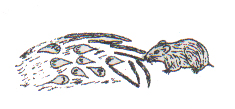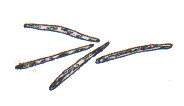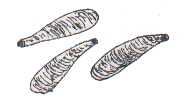 This collection of student work is from Frank Keim's classes. He wants to share these works for others to use as an example of culturally-based curriculum and documentation. These documents have been OCR-scanned and are available for educational use only.
This collection of student work is from Frank Keim's classes. He wants to share these works for others to use as an example of culturally-based curriculum and documentation. These documents have been OCR-scanned and are available for educational use only.Special | A | B | C | D | E | F | G | H | I | J | K | L | M | N | O
P | Q | R | S | T | U | V | W | X | Y | Z | ALL
Ugnarat Neqait - Mouse Food: UGNARAT NEQAIT-MOUSE FOOD UGNARAT NEQAIT-MOUSE FOODFall is the season I start picking mouse foods. Most mouse food is found under the soft ground of the tundra. We have to step on the ground to try and find it. Three types of mouse food are: "UTNGUNGSAAT", "MARALLAT", AND "IITAT":  UUTNGUNGSAAT UUTNGUNGSAATWe boil "UTNGNUNGSAAT" for awhile until they're soft. We eat them with seal oil. Eating them with seal oil will satisfy your stomach. Besides eating "UTNGUNGSAAT" with seal oil, we also can add tomcod eggs or liver to them. It is very tasty this way.  MARALLAT-YUPIK POTATOES MARALLAT-YUPIK POTATOES"MARALLAT" are Yupik potatoes that are also mouse food. We boil "MARALLAT" until they are soft just like we boil "UTNGUNGSAAT". After boiling them, we pour out the broth of the soup and eat the cooked "MARALLAT" in our bowls. We can eat them with dry fish or other Yupik food too. It tastes very good that way. By Josephine Smart
Interviewed by E. Joe IITAT "IITAT" is another type of mouse food. They are long and dark in color. "IITAT" are eaten by mice but we also eat them because they are very nutritious. The Yupik people have eaten mouse food since long ago. First, we have to clean "IITAT" very good before cooking them, then we boil them. Then we cut them up and add them to salmon berries for akutaq. We also cook "IITAT" with tomcod livers and with other types of mouse food. We can also add them to seal meat. We start picking mouse food in the tundra in late September. And also in early October. Girls and women pick "IITAT". By Dick Bunyan Interview by Patty Murran and Ike Tall | |
|



 They dig them from the tundra and put them in their grass baskets. Only the women work with "IITAT". They boil them and other types of mouse food for lunch and supper. They make a delicious soup.
They dig them from the tundra and put them in their grass baskets. Only the women work with "IITAT". They boil them and other types of mouse food for lunch and supper. They make a delicious soup.